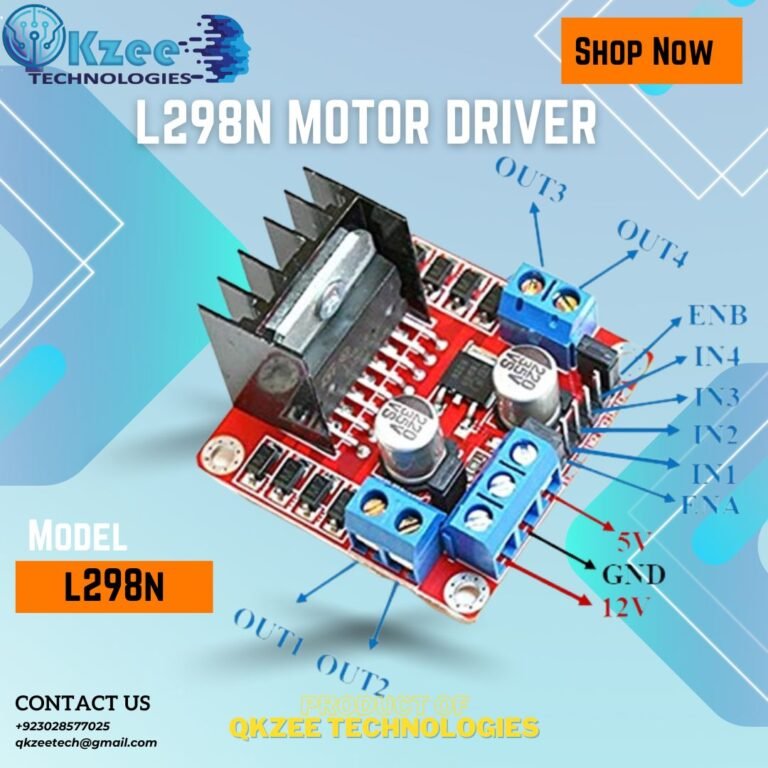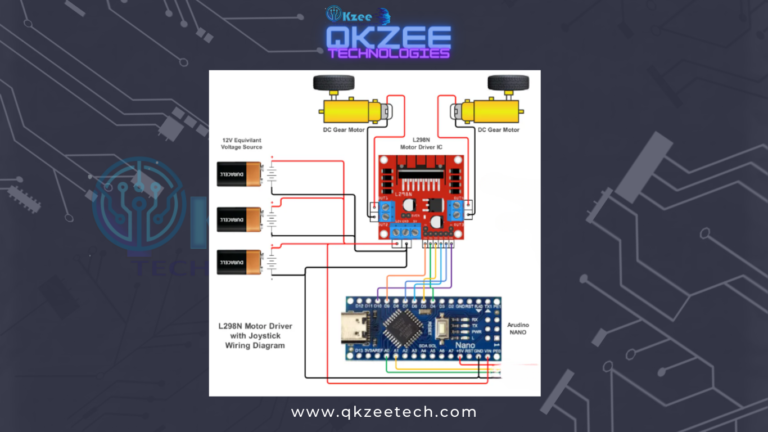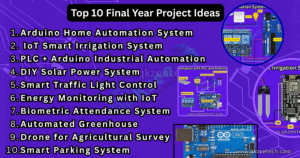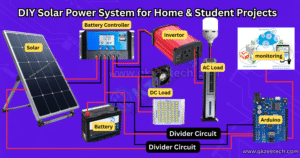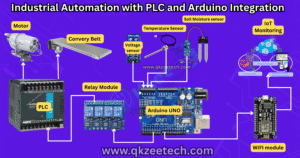Mastering Motor Control: A Guide to Unleashing the Power of L298N Motor Driver
Introduction
Are you looking to add motor control to your Arduino projects? The L298N motor driver might be just what you need. This module is a popular choice for hobbyists and professionals alike, offering an easy way to control DC and stepper motors. From student projects to final year projects in engineering, the L298N is versatile and reliable. In this article, we’ll dive deep into the L298N, covering its description, pin configuration, uses, features, and more. Ready to get started? Let’s go! pin configuration, uses, features, and more. Ready to get started? Let’s go!
What is the L298N Motor Driver?
The L298N motor driver is a dual H-bridge motor driver module that allows for the control of the speed and direction of two DC motors or one stepper motor.
The L298N motor driver is a powerful module capable of simultaneously driving two DC motors or one stepper motor. It uses the H-bridge configuration, allowing full control over the motor’s direction and speed. The module can be easily interfaced with Arduino and other microcontrollers, making it a popular choice for various robotics and automation projects.
Specifications and Features
Technical Specifications of L298N
Voltage Requirements
The L298N can handle motor supply voltages from 5V to 35V, making it suitable for various applications.
Current Rating
Supported Motors
The L298N is compatible with both DC motors and stepper motors, providing flexibility for various types of projects.
Configuration of the L298N
Overview of the Pins
The L298N has several pins and terminals for connecting power, control signals, and motors. Here’s a breakdown of the key pins:
- VCC
- GND
- IN1, IN2, IN3, IN4
- OUT1, OUT2, OUT3, OUT4
- ENA, ENB
- 12V
Detailed Pin Description
VCC: This pin is for the logic power supply, typically connected to a 5V source.
GND: This is the ground pin.
IN1, IN2, IN3, IN4: These pins are used to control the direction of the motors. IN1 and IN2 control the first motor, while IN3 and IN4 control the second motor.
OUT1, OUT2, OUT3, OUT4: These are the output pins connected to the motors. OUT1 and OUT2 connect to the first motor, and OUT3 and OUT4 connect to the second motor.
ENA, ENB: These are the enable pins for the motors. ENA enables the first motor, and ENB enables the second motor. These pins can be used to control the speed of the motors via PWM (Pulse Width Modulation).
12V: This pin is for the motor power supply, connected to a power source that matches the voltage requirements of the motors.
How to Connect the L298N to an Arduino
Step-by-Step Guide
- Gather Components: You’ll need an L298N module, an Arduino board, jumper wires, and a power source for the motors.
- Connect Power: Attach the 12V pin of the L298N to the motor power supply, the VCC pin to the Arduino’s 5V pin, and the GND pin to the Arduino’s ground.
- Connect Control Pins: Connect IN1, IN2, IN3, and IN4 to four digital pins on the Arduino.
- Connect Motors: Connect the motors to the OUT1, OUT2, OUT3, and OUT4 pins of the L298N.
- Enable Pins: Connect ENA and ENB to two PWM pins on the Arduino to control motor speed.
Setting Up the L298N Module
Configuring the ENA and ENB Pins
The ENA and ENB pins are used to enable the motors and control their speed using PWM signals from the Arduino. These pins must be connected to PWM-capable digital pins on the Arduino.
Connecting Power and Ground
Ensure that the power supply for the motors is adequate and that the GND pins of the L298N and Arduino are connected to a common ground.
Wiring the Motors
Connect your motors to the OUT1, OUT2, OUT3, and OUT4 pins. Ensure the connections are secure to prevent any loose connections.
Programming the Arduino for L298N Motor Control
Sample Code
int IN1 = 10;
int IN2 = 9;
int ENA = 8;
int IN3 = 7;
int IN4 = 6;
int ENB = 5;
void setup() {
pinMode(IN1, OUTPUT);
pinMode(IN2, OUTPUT);
pinMode(ENA, OUTPUT);
pinMode(IN3, OUTPUT);
pinMode(IN4, OUTPUT);
pinMode(ENB, OUTPUT);
}
void loop() {
digitalWrite(IN1, HIGH);
digitalWrite(IN2, LOW);
analogWrite(ENA, 255);
digitalWrite(IN3, HIGH);
digitalWrite(IN4, LOW);
analogWrite(ENB, 255);
delay(2000);
digitalWrite(IN1, LOW);
digitalWrite(IN2, HIGH);
analogWrite(ENA, 255);
digitalWrite(IN3, LOW);
digitalWrite(IN4, HIGH);
analogWrite(ENB, 255);
delay(2000);
}
Explanation of the Code
This code sets up the L298N motor driver with two motors. The motors will spin in one direction for 2 seconds, then reverse direction for another 2 seconds. The analogWrite fnction is used to control the speed of the motors via PWM
Common Uses of the L298N Motor Driver
Controlling DC Motors
The L298N is perfect for controlling the speed and direction of DC motors in various projects.
Controlling Stepper Motors
Use the HC-06 to control lights, thermostats, and other home appliances from your smartphone or computer.
Robotics Projects
Use the L298N to control the movement of robots, providing precise control over speed and direction.
Student Projects
Ideal for student projects, the L298N motor driver helps in learning about motor control and electronics.
Final Year Projects
For final-year projects, the L298N offers a robust solution for complex motor control applications.
Qkzee Technologies
Used widely by Qkzee Technologies in their innovative projects and solutions.
Engineering Projects
Essential in engineering projects, especially those involving automation and robotics.
Features of L298N Module
Key Features
- Dual H-bridge configuration
- Supports both DC and stepper motors
- High current capability
- PWM speed control
- Easy interface with Arduino
Advantages
The
- Cost-effective
- Reliable performance
- Versatile for various applications
L298n Motor Driver Troubleshooting Common Issues
Motor Not Running
Check the power connections and ensure that the control pins are correctly connected and programmed.
Overheating Problems
Ensure adequate cooling and heat dissipation for the L298N module. Consider using a heatsink if necessary.
Power Issues
Verify that the power supply is sufficient for the motors being used. Check for loose connections.
Tips for Optimizing L298N Performance
Proper Heat Dissipation
Use heatsinks and ensure proper ventilation to prevent the module from overheating.
Ensuring Adequate Power Supply
Make sure your power supply meets the voltage and current requirements of the motors and the L298N module.
Security Considerations for L298n Motor Driver
Protecting Your Electronics
Use proper fuses and protection circuits to prevent damage to your electronics.
Ensuring Safe Operation
Follow safety guidelines to avoid short circuits and other hazards.
Comparing L298N with Other Motor Drivers
L293D vs. L298N
The L298N can handle higher currents compared to the L293D, making it more suitable for larger motors.
Other Alternatives
Consider alternatives like the DRV8833 or the BTS7960 for more advanced features and higher-power applications.
Advanced Configurations and Hacks of L298n Motor Driver
Controlling Multiple Motors
You can control more than two motors by cascading multiple L298N modules.
Customizing Firmware
Advanced users can modify the firmware to unlock additional features and optimize performance.
Conclusion
The L298N motor driver is a versatile and reliable component for adding motor control to your Arduino projects. Its ease of use, affordability, and robust performance make it a favorite among hobbyists and professionals alike. Whether you’re working on home automation, robotics, or simple motor control, the L298N is an excellent choice. Plus, if you’re in Lahore or shopping at Hall Road, you’ll find it to be one of Pakistan’s best solutions for motor control.
What types of motors can the L298N control?
The L298N can control both DC motors and stepper motors, making it versatile for various applications.
How to prevent the L298N from overheating?
Use heatsinks and ensure proper ventilation to prevent the module from overheating.
Can the L298N be used for high-power applications?
The L298N can handle up to 2A per channel, with a peak current of 3A, making it suitable for most small to medium-sized motors.
What is the maximum current rating of the L298N?
The L298N can provide up to 2A continuous current per channel, with a peak current of up to 3A.
How to troubleshoot common L298N issues?
Check power connections, ensure proper wiring, and verify that the control signals are correctly configured.

